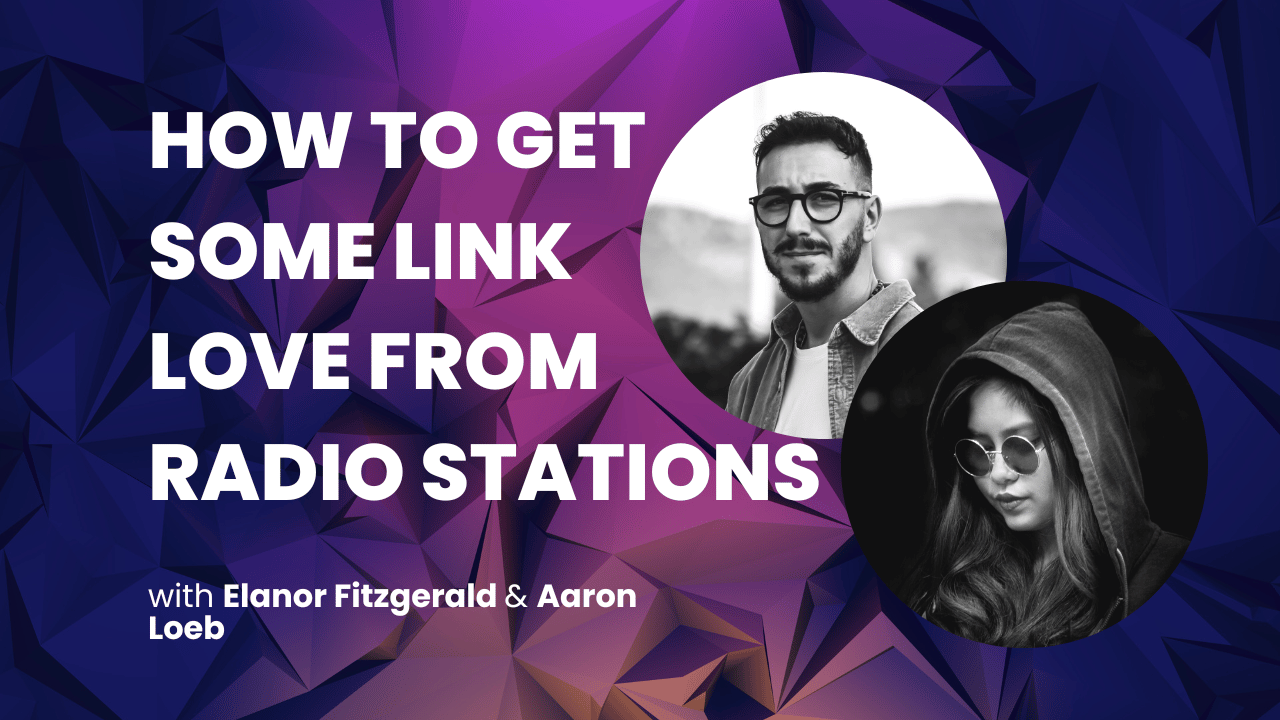SEO
iHeartLinks: How to Get Some Link Love from Radio Stations
- Introduction
- What is iHeartLinks?
- Importance of links from radio stations
- Understanding iHeartLinks
- What is iHeartMedia?
- How iHeartLinks can benefit your website
- Researching Relevant Radio Stations
- Identifying your target audience
- Finding radio stations that align with your niche
- Building Relationships with Radio Stations
- Reaching out to radio station managers
- Presenting your website as a valuable resource
- Crafting Compelling Pitches
- Tailoring your pitch to each radio station
- Highlighting the unique value of your website
- Leveraging Guest Appearances
- Offering expertise for interviews or discussions
- Demonstrating your knowledge and credibility
- Creating Engaging Content for Radio Stations
- Developing content ideas that resonate with radio audiences
- Providing valuable resources for listeners
- Promoting Your Radio Appearances
- Sharing announcements on your website and social media
- Encouraging listeners to visit your website for more information
- Measuring the Impact of iHeartLinks
- Tracking referral traffic from radio stations
- Monitoring engagement and conversion metrics
- Building Long-Term Relationships
- Maintaining regular communication with radio stations
- Exploring opportunities for ongoing collaborations
- Conclusion
- FAQ
- How long does it take to see results from iHeartLinks?
- Can any website benefit from iHeartLinks?
- Are there any costs associated with iHeartLinks?
- What if a radio station doesn’t respond to my pitch?
- Can I approach multiple radio stations at once?
iHeartLinks: How to Get Some Link Love from Radio Stations
In today’s digital landscape, securing high-quality backlinks is essential for improving your website’s search engine rankings and driving organic traffic. While most SEO strategies focus on online platforms, there’s an untapped resource that can offer valuable link opportunities – radio stations. In this article, we’ll explore iHeartLinks, a technique that can help you harness the power of radio stations and acquire valuable backlinks.
Introduction
What is iHeartLinks?
iHeartLinks is a term coined to describe the process of obtaining backlinks from radio stations, particularly those affiliated with iHeartMedia, the leading audio entertainment company in the United States. These backlinks provide authoritative signals to search engines, helping to boost your website’s visibility and credibility in the digital space.
Importance of links from radio stations
Backlinks from reputable sources, such as radio stations, carry significant weight in search engine algorithms. They indicate to search engines that your website is trustworthy and relevant. When radio stations link to your site, it can drive targeted traffic, increase brand exposure, and improve your website’s overall authority.
Understanding iHeartLinks
What is iHeartMedia?
iHeartMedia is a multi-platform media and entertainment company that reaches millions of consumers every month through its vast network of radio stations, podcasts, and digital platforms. With over 850 radio stations across the United States, iHeartMedia provides a unique opportunity to connect with diverse audiences.
How iHeartLinks can benefit your website
By leveraging iHeartLinks, you can tap into the broad listener base of radio stations and attract visitors who are interested in your niche or industry. These backlinks can boost your website’s organic search rankings, enhance brand visibility, and generate valuable referral traffic.
Researching Relevant Radio Stations
Identifying your target audience
Before diving into iHeartLinks, it’s crucial to identify your target audience. Determine who your ideal customers or visitors are and understand their interests, demographics, and preferences. This knowledge will help you find radio stations that align with your niche and target market.
Finding radio stations that align with your niche
Research various radio stations within your target market and identify those that cater to your audience’s interests. Look for stations that cover topics related to your industry or niche. Consider factors such as the station’s format, listenership demographics, and geographic reach to ensure alignment with your target audience.
Building Relationships with Radio Stations
Reaching out to radio station managers
Once you have identified relevant radio stations, it’s time to establish connections with their managers. Start by researching the station’s website or social media profiles to find contact information. Craft a concise and personalized email introducing yourself and expressing your interest in collaborating with the station.
Presenting your website as a valuable resource
When reaching out to radio station managers, highlight the unique value your website offers to their audience. Explain how your content, products, or services can enhance the listening experience and provide valuable resources to their listeners. Emphasize how a collaboration with your website can benefit both the radio station and its audience.
Crafting Compelling Pitches
Tailoring your pitch to each radio station
Personalization is key when pitching your website to radio stations. Take the time to understand each station’s format, audience, and content preferences. Customize your pitch accordingly, showcasing how your website aligns with their station’s values and can add value to their programming.
Highlighting the unique value of your website
In your pitch, emphasize the unique aspects of your website that set it apart from competitors. Focus on what makes your content valuable, engaging, and relevant to the radio station’s audience. Whether it’s exclusive resources, expert insights, or captivating stories, make it clear why the station should consider featuring your website.
Leveraging Guest Appearances
Offering expertise for interviews or discussions
One effective way to secure backlinks from radio stations is by offering your expertise for interviews or discussions. Position yourself as an industry expert and propose topics that are timely, relevant, and engaging. Be prepared to provide valuable insights that educate and entertain the station’s audience.
Demonstrating your knowledge and credibility
During your guest appearances, ensure you deliver valuable content that showcases your expertise. Be engaging, informative, and authentic. By providing valuable information to the audience, you establish yourself and your website as a trusted resource, increasing the likelihood of listeners visiting your website.
Creating Engaging Content for Radio Stations
Developing content ideas that resonate with radio audiences
When creating content for radio stations, consider the preferences and interests of their audience. Craft compelling stories, intriguing discussions, or informative segments that align with the station’s format and cater to their listeners. Ensure your content is engaging, relevant, and tailored to the specific radio station and its audience.
Providing valuable resources for listeners
In addition to creating content that entertains and informs, offer valuable resources that listeners can access on your website. This could include downloadable guides, exclusive discounts, or additional information related to the topics discussed on the radio. By providing value beyond the on-air experience, you encourage listeners to visit your website and explore further.
Promoting Your Radio Appearances
Sharing announcements on your website and social media
Once you have secured a guest appearance on a radio station, leverage your digital platforms to amplify the announcement. Create blog posts, social media updates, or newsletters to inform your audience about the upcoming radio appearance. Encourage them to tune in and share the news with their networks.
Encouraging listeners to visit your website for more information
During your radio appearances, mention your website as a source for additional information or resources related to the topics discussed. Provide clear calls-to-action for listeners to visit your website, subscribe to your newsletter, or engage with your content. Make it easy for them to find and explore your website.
Measuring the Impact of iHeartLinks
Tracking referral traffic from radio stations
Monitor your website analytics to track the traffic coming from radio stations. Use tools like Google Analytics to identify the specific radio stations driving the most traffic to your site. Analyze user behavior, conversion rates, and engagement metrics to assess the impact of iHeartLinks on your website’s performance.
Monitoring engagement and conversion metrics
In addition to tracking traffic, pay attention to engagement and conversion metrics. Measure the average time users spend on your site, the number of pages they visit, and the actions they take, such as subscribing to your newsletter or making a purchase. These metrics provide insights into the effectiveness of your iHeartLinks strategy.
Building Long-Term Relationships
Maintaining regular communication with radio stations
Building relationships with radio stations is an ongoing process. Stay in touch with station managers and hosts to nurture the connections you have established. Share updates, new content, or collaboration ideas to keep your website top of mind for future opportunities.
Exploring opportunities for ongoing collaborations
Look for opportunities to collaborate with radio stations beyond guest appearances. Explore options such as sponsored segments, contests or giveaways, and co-branded content. By fostering long-term collaborations, you can continue to benefit from the link love and exposure provided by radio stations.
Conclusion
Incorporating iHeartLinks into your SEO strategy can unlock valuable link opportunities and broaden your reach beyond the online realm. By researching relevant radio stations, building relationships, crafting compelling pitches, leveraging guest appearances, creating engaging content, and measuring the impact, you can tap into the power of radio stations to boost your website’s visibility, authority, and organic traffic.
FAQ
1. How long does it take to see results from iHeartLinks?
The timeline for seeing results from iHeartLinks can vary depending on various factors such as the frequency of your radio appearances, the size of the radio station’s audience, and the relevance of your content to the listeners. It’s important to approach iHeartLinks as a long-term strategy and consistently work on building relationships and creating valuable content.
2. Can any website benefit from iHeartLinks?
While iHeartLinks can be beneficial for many websites, it’s important to ensure that your website aligns with the interests and demographics of the radio stations’ audience. Conduct thorough research to identify radio stations that cater to your target market and offer content that resonates with their listeners.
3. Are there any costs associated with iHeartLinks?
Securing backlinks from radio stations through iHeartLinks typically doesn’t involve direct costs. However, building relationships and creating valuable content may require time and effort. Additionally, you may choose to invest in promoting your radio appearances through paid advertising or sponsorships.
4. What if a radio station doesn’t respond to my pitch?
Not every radio station will respond to your initial pitch, and that’s normal. Radio stations receive numerous requests and pitches regularly. If you don’t receive a response, consider following up politely after a reasonable period. Alternatively, focus on other stations that show more interest or explore additional avenues for link-building opportunities.
5. Can I approach multiple radio stations at once?
Yes, you can approach multiple radio stations at once. However, it’s crucial to customize your pitches for each station and avoid using generic templates. Take the time to understand each station’s format, audience, and content preferences to tailor your pitch accordingly. Building genuine relationships and offering unique value will increase your chances of success.

